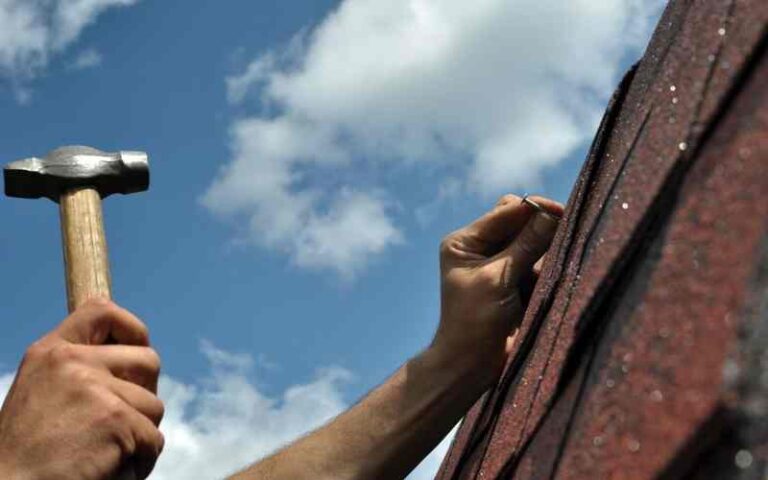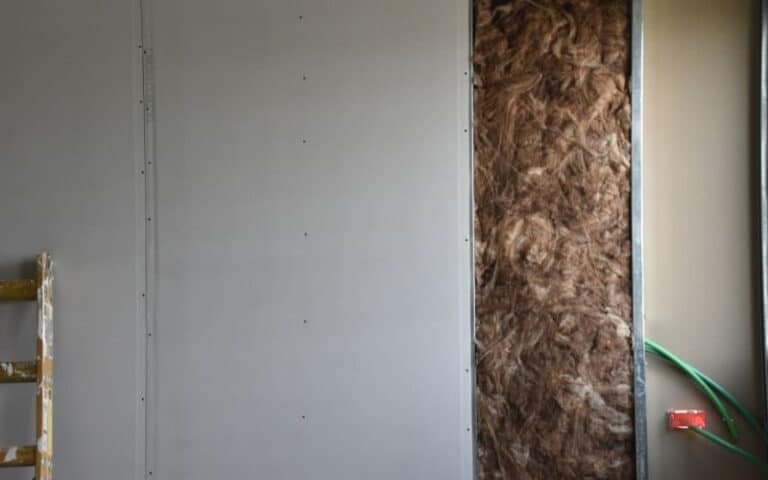It’s pretty common to find holes in your roofing felt. If discovered early, you should repair it to prevent water from leaking into the loft.
The roofing system is one part of your house that requires a high level of maintenance. You can fix leakages from the inside or outside.
Roof felt acts as a moisture barrier. When the temperature is high and reaches the roof, the moisture that condenses under the shingles will be trapped by the roofing felt.
Roof felt can be repaired from the inside. You can do this by placing a piece of felt over the hole and using sealants to stop any small drips. In addition, you can repair tears in the roof felt using bitumen-based roofing felt adhesive.
Ready for a Roofing Quiz?
Ready for a Drywall Quiz?
Can Roof Felt Be Repaired?

Yes, the roof felt can be repaired. Roof felt has a lifespan of 20 to 30 years. In extreme weather or other conditions, its lifespan can be cut short.
The source of roof leaks is sometimes hard to find because it originates from where the leak shows up. They may also be challenging to fix.
Before a flat roof leaks, there are warning signs to look out for. Some of these signs are damp, dark brown patches on the ceiling, drips or moisture on the walls, moist-looking paint or drywall around light or electrical outlets, dripping sounds, or a musty smell.
This indicates that moisture is seeping through your roof. In addition, if your room is old and exposed to elements, it may sag.
This is an indication that the timbers have begun to rot. Some significant causes of flat roof leaks are:
#1. Age
No matter how perfectly they were installed, roofing materials degenerate with time. Harsh weather conditions, extreme temperature, etc., will cause wear and tear.
In recent times, manufacturers are now producing long-lasting roofing products. Unfortunately, your roof may be leaking because it has reached the end of its useful life.
#2. Poor Installation
If not installed properly, your roof will be vulnerable to leaks. Therefore, you must install roofs per the manufacturer’s guidelines.
Next, get a qualified professional roofer to install your roofing system. Though expensive, it prevents future maintenance costs and assures you that your roof is secure.
#3. Water Ponding
Most flat roofs have a pitch of 1:40 which may not shed water completely after a heavy downpour. This may cause your roof to lose its pitch and cause water to pool in certain areas of your roof.
If the water remains there for more than 48 hours, it can seep into the space leading to roof leaks. Therefore, you should drain pooling water to prevent long-term damage.
#4. Overlaps
Your roof could spring leaks at the overlaps. It is common in areas where the overlap is not sealed correctly.
#5. Lead Flashing
When exposed to extreme temperatures, the metal heats up or cools down. As a result, it will expand and contract and eventually lead to roof leaks as time goes by.
#6. Blisters
If you notice blisters on the surface of your flat roof, it is an indication that water is under your roofing material.
Blistering is caused by damp timbers, insulation, and condensation. When these blisters burst open, they cause roof leaks.
#7. Poor Design And Structural Issues
Two things that could cause roof leaks are structural issues and poor design. In addition, inadequate pitch features lead to pooling water and leaks.
To find the leaking area, start by looking for holes. A flat roof repair is complicated, while a metal roof repair is less complicated.
Consult a professional roofer if the roof leak is noticeable and you can’t fix it yourself. It is essential to examine your roof always, especially if you have just experienced a significant weather event.
Finding leaks on flat roofs is trickier than finding leaks on pitched roofs. On a pitched roof, you can trace the leaks to materials directly above, but on a flat roof, water can move in all directions between the layers of your roof space before it leaks into the rooms.
Therefore, you will have to climb up the roof for the easy location of leaks on your flat roof. You may read our post if you don’t know how to climb up the roof.
The ideal time to do this is when the roof has been dry for more than 48 hours, and you should do it in the evening.
If the weather has been dry for some time, look for water stains, marks, or discolorations on the wood caused by the moisture. Turn off your lights and look out for the spots light penetrates through the roof.
With experience in construction, you can repair it yourself. However, incorrectly repairing it may lead to more significant problems, and as such, you are advised to have a professional roofer repair it.
Another critical thing to keep in mind if you want to fix it yourself is your safety. Do not attempt walking on a roof if you are not used to it.
Consider the strength of your roof before stepping on it.
If the roof is old and has been leaking, it is most likely that the roof timbers have become rotten in certain areas. You can repair tears or splits in the roof felt without causing further damage.
Have a roofing contractor inspect your roof annually to determine any problem before it causes damage.
Can You Patch Roof Felt From The Inside?
You can patch roof felt from the inside. If the felt on your roof is damaged, a simple and cost-effective method of resolving it is to patch it up rather than replace all of the felt.
Call a professional roofer to perform an inspection so that you will know if a patch will extend your roof’s lifespan without leading to future damages. In most cases, you will find it challenging to locate a small patch.
However, it is ideal for keeping small pieces of felt for later use when buying. You will need a knife, a small patch of matching felt, and cold felt adhesive to patch up your roof.
#1. Prepare The Hole
When you have seen the hole, cut out a square or rectangle of the felt around the damaged spot to have flat and clean edges.
Next, measure the hole you just cut and cut a piece of spare felt so that it is larger than the hole.
#2. Mark The Patch
Place the patch you cut out on the hole and mark the edges with chalk to know where to apply the cold felt adhesive.
#3. Apply the adhesive
Use a paintbrush to apply the adhesive on the margin you marked around the hole. Avoid spreading it outside the marked areas. Leave the adhesive to dry for 20 minutes to ensure it becomes sticky.
#4. Laying the patch
Lay your patch to position over the hole and press it firmly. You can use a small roller if you have one to smoothen the patch. Make sure there are no air bubbles under the patch.
If your area is prone to extreme weather conditions, you might want to invest in a new roof. Patched-up roofs can be damaged by winds and heavy rains, while a new one will give you more robust protection.
Also, if your roofing is above 20 years, there might be damages you are not aware of. Patching up may extend the lifespan of your roofing felt, but it won’t last as long as a new one.
Summary
Replacing your roof felt is best because it can be challenging to know the degree of damage caused by water.
Instead, you should strip off your roof felt to inspect and repair the roof timber before laying a new layer of roofing felt.






